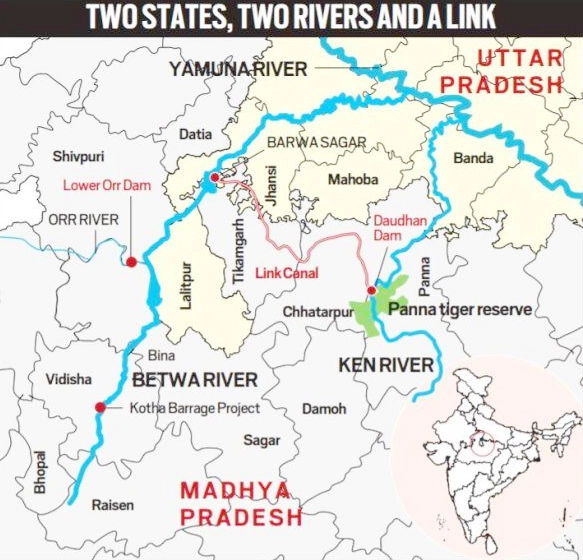-
14 Jan 2025
GS Paper 1
Geography
Day 38: The Ken-Betwa Link Project (KBLP) is often proposed as a solution to water scarcity, flood control, and irrigation issues. Critically analyze. (250 Words)
Approach
- Introduce the Ken-Betwa Link Project (KBLP) and its objectives briefly.
- Analyze the potential benefits and challenges with examples and data.
- Conclude with a balanced perspective emphasizing sustainability.
Introduction
Under the National Perspective Plan (NPP) 1980, the National Water Development Agency (NWDA) has identified 30 links (16 under the Peninsular Component and 14 under the Himalayan Component) for feasibility reports. The Ken-Betwa Link Project (KBLP) is a key initiative under this plan, addressing drought and promoting regional development in Bundelkhand.
Body
Potential Benefits:
- Ensures Water Availability: The KBLP aims to transfer surplus water from the Ken River in Madhya Pradesh to the Betwa River in Uttar Pradesh, providing a reliable drinking water supply for 6.2 million people across 22 districts.
- This will mitigate water shortages that have long plagued regions like Bundelkhand.
- Boosts Irrigation and Agriculture: With irrigation coverage of 6.3 lakh hectares annually, the project will benefit 2,000 villages, ensuring water availability for farmers.
- Reliable irrigation will enhance agricultural productivity, reduce dependence on monsoon rains, and help tackle drought-induced migration by improving rural livelihoods.
- Generates Renewable Energy: The project will generate 103 MW of hydropower and 27 MW of solar energy, contributing to India’s renewable energy capacity and reducing reliance on non-renewable sources.
- Reduces Flood Risks: By channeling excess water from the Ken River to the Betwa River, the project addresses the dual problem of floods and drought, ensuring better water resource management.
- Promotes Regional Development: Bundelkhand, historically drought-prone and underdeveloped, stands to benefit significantly.
- Improved water availability will facilitate economic growth, support industrial development, and create employment opportunities, addressing regional disparities.
Challenges and Criticisms:
- Environmental Concerns: The project will submerge over 10% of the Panna Tiger Reserve’s core area, threatening critical habitats for tigers, vultures, and other species.
- Additionally, the felling of 23 lakh trees for construction activities risks deforestation and ecological imbalance.
- Wildlife Displacement and Ecosystem Disruption: Alteration of river ecosystems may affect fish populations and aquatic biodiversity, impacting the livelihoods of communities dependent on these resources.
- High Financial Costs: The project’s estimated cost of ₹44,605 crore poses a significant financial burden, raising concerns over cost-benefit efficiency, particularly for such large-scale infrastructure projects.
- Social and Legal Issues: The project involves the displacement of local communities, affecting their livelihoods and social stability.
- Moreover, potential disputes over water sharing between states could complicate the implementation of interlinking projects.
- Uncertainty Due to Climate Change: Changes in rainfall patterns and reduced water availability in surplus rivers, influenced by climate change, could render interlinking projects less effective over time, questioning their long-term sustainability.
Conclusion
While river interlinking offers a potential solution to address India’s water and irrigation challenges, projects like the Ken-Betwa Link must balance developmental benefits with environmental conservation and social equity. A sustainable and adaptive approach, supported by robust safeguards and cooperative governance, is crucial to ensure its success and minimize adverse impacts.





